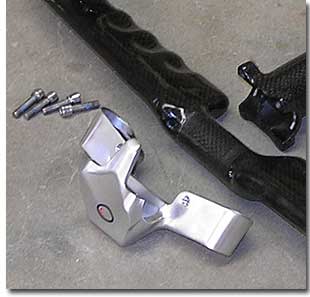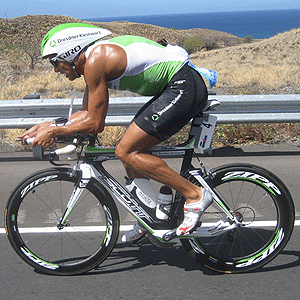3T takes the shorty bar forward
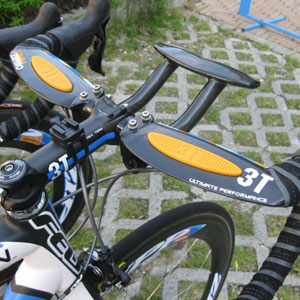
Midway through the recently contested Giro d'Italia the riders faced an intriguing stage. The Cinque Terre individual time trial was 36 miles long, included two medium ascents, and hundreds of twists and turns. The riders faced a choice: time trial bike or road race bike? Most chose the latter.
But it was a close call, and the calculus was this: Do I ride a road race bike with an aero position? Or a time trial bike with a pursuit position? Think about this for a moment, because it's a profound fit and technology decision every triathlete must face. His retailer selling to him must likewise face it, along with his fitter, and originally the company making his bike.
The question is this: What is your preferred position? Or more precisely, what is your deferred to position? What's preeminent? What's the default? Is it the aero position? Is this the position to which everything on your timed race bike defers? If so, then everything on the bike—its geometry, your weight displacement, seat angle, hand positions—must defer to your aero position. In this case, every time you're not in the aero position, you have an inferior bike to those who're aboard bikes that defer to the road position.
This doesn't mean that whenever you're out of the aero position you're on a bad bike, or that you can't do everything you can to make your aero bike better when you're out of the aero position. Look at it this way. Do you own an SUV? Are you using it for commuting to work? Are you also using it as a rock crawler at the Jeeper's Jamboree? Fine, it can do both, but if you set it up to do one thing well, then it's going to be inferior when going up against other vehicles set up to do the other thing well.
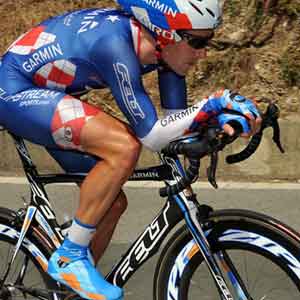
Most riders thought the road position needed preeminence during the Cinque Terre time trial. In this case, a "shorty bar" is called for, and 3T has just taken the next step forward in the design and manufacture of this style of bar.
"Will many triathletes be interested in this?" you might ask. You bet, and it's not the group of athletes you think I'm going to talk about. Yes, this is a great bar for ITU riders, and it's instantly far ahead of every ITU bar currently in the triathlon "peloton," for reasons I'll describe below. But remember what we covered above. Before you decide what handlebar you want, you need to stand back and answer a big picture question: What is my preferred position, to which everything on the bike defers? The road position, with my hands on the tops, the hoods, the drops, and with my saddle back at 73°? Or the aero position, where I ride at 79° of seat angle, and whenever I'm out of the aero position—which I'll hardly ever be—I'm on a bike that's not optimized?
The truth is, a lot of triathletes just aren't going to spend that much time in the aero position. Maybe it's due to the sixth grader you're carrying around just above your beltline. Maybe you just can't or don't want to endure mile after mile on the nose of the saddle, resting your weight on a place God designed for other purposes? Maybe it's because you have one bike for all sorts of riding, and that bike needs to do everything, and "everything" includes a lot of road race style riding. The reason doesn't matter. The only thing that matters is how you answer the question: What is the position to which everything on my bike will defer: aero or road?
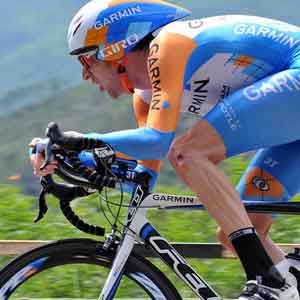
3T Zefiro
This is not a bar for a tri bike. You should not put this bar on a Felt B2, or a Cervelo P3, or a Specialized Transition. This is a bar for a road race bike. When you put this on a road bike, what you're saying is, "I'm not going to ride a tri bike, or a tri bike position; my interest is in preserving my road bike positions, in particular the hoods, tops, drops, and the ability to ride out of the saddle." Yes, I want an aero position, but what I want is the best aero position I can get on an otherwise road-race-optimized bike.
What the Zefiro gives you is all of that, with none of the annoyances that often attend shorty bars.
What are those annoyances? Armrests that sit too high up in the air. Brackets and armrests that take away your ability to ride with your hands on the tops. Brackets also inhibiting your ability to route cables, especially on today's levers that in most cases route both shift and brake cables adjacent to the road bar.
What does the Zefiro do that other bars, notably Oval Concepts' R910 road bar mated with its A711 Stem Cap Clip-on System, do not do as well? The Zefiro's improvements are as follows:
Cable routing
The Zefiro's cables are routed internally, and the brackets are integrated into the bar, and away from the "tops." I'm not going to sit here and tell you the Zefiro's cable routing was a dream. It took an old-style bicycle spoke fishing a cable through, chasing casing back over the cable, 45 minutes, and curse words I thought I'd left behind, before it was all done. I think my Oval Concepts R910 was an easier route. But the Zefiro's routing scheme—the placements of the holes—allows me to affix the hoods where I want on the hooks. The Oval bar's pre-drilled holes really only allowed me to put the hoods in one place. The Zefiro's routing scheme let's me place the bar where I want around its rotational axis, then place the hoods where I want around their rotational axis. And I must also say that this is a very early version of the Zefiro, I'll guess the routing will be cleaned up in production.
Tops
The Oval Concepts R910 is flat across the top, and that's great. The Zefiro is also flat across the top. But the Zefiro is a bit more ergonomic when used as an armrest. With all road bars of this style, this "flat" isn't parallel to the ground, but angled slightly up, to act as a brace against the hands slipping forward and off the bar entirely when the rider hits a bump or pothole. But the upward slanting of the Zefiro is softened by a larger radius curve on its leading edge. Also, the Zefiro's tops can be a bit flatter—more parallel to the ground—because its rubber "armrest," such as it is, offers a bit of grip for the hands when they're on the tops (as in while seated climbing).
Hand position
If you just extend forward with your road bike and place your hands on the tops (which many riders do even without a shorty bar affixed), you'll notice that your hands rest on the bars palms-down, rather than palms facing each other, as is the case with a full aero bar on a full tri bike (look at the two Garmin-Chipotle rider pics above). Therefore, shorty bar extensions that mirror those of full aero bars are an ergonomic failure. The "wing" of the Zefiro is not a spoiler, or an attempt at aerodynamics. It represents a correct reading of the problem: The hand-hold position must be horizontal to the bike's direction, not along the same bias as the bike travels.
3T has absolutely nailed this problem. Fortunately for at least one other company—Oval Concepts—its A711 system is primed and ready for an extension that does what the Zefiro does. Oval just needs to make the extension.
Room for improvement?
The Zefiro is such a choice bike component, I'm going to hate destroying it. Nevertheless, like Pam Anderson going in for plastic surgery, one must sometimes place at risk near perfection in order to get absolute perfection. So, tinker I must.
When I put the Zefiro on my bike, I had to take off my 12cm stem and replace it with an 11cm stem. Why? Because the length of the Zefiro, from handlebar clamp to the forward protrusion of the hooks, is 1cm longer than on most of my existing road bars, including the one I had on my road race bike prior to mounting the Zefiro. On my road bike, "hoods" is that position to which all others defer. The 11cm stem placed my hoods in the right spot (the right distance from my saddle, and from the bottom bracket). But now, my "tops" were 1cm too short (too close to my saddle).
So, I feel a bit cramped while seated climbing with my hands on the tops. What would be helpful is if there was something out there to grab—something in front of the tops. The wing won't work; while the tops are too close the saddle, the wing is too far away from the saddle. The tubes leading from the bar to the wing are down below and not available to grab. So, if there was a bar, or some sort of extension, level with the tops, leading from the tops to the wing, I could grab that and I'll be happy. I'll cobble this up and epoxy it in place, and see how it works. I'll take pics of it and post it in a future article.
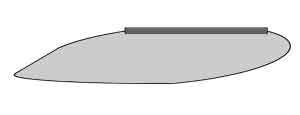
More armrest area
As good as the Zefiro is, it's possible there are, perhaps, other cross sections worth considering for the road bar. For example, adjacent is a shape that might act as both a brace for the hands while seated climbing or easy riding on the flats, as well as a horizontal plane on which to place a piece of EVA or polyurethane "armrest."
How you must ride this bar
If I haven't made it plain, let me restate with no ambiguity: This bar is to be placed on a road race bike with everything in a standard road position. No changes. In so doing, you're deferring to your road position in every way.
That established, I've been riding this bar in the aero position, and while it's not quite what I've got when I'm on my tri bike in my tri position, it's a position I can ride comfortably for a long time. This is the first shorty bar I've ever been able to ride in the aero position more or less comfortably.
The one deviation from my road bike is this: You ride this with some sort of tri saddle. It must be a tri saddle that is also a good road saddle, since the bike is a road bike with a tri position, rather than a tri bike with a pursuit position. A Fizik Arione Tri II would be great.
Why this type of saddle? Because my road race seat angle is 73°, and I really must nose ride this bike while in the aero position (what Versus Channel commentators call riding "on the rivet") . So, I must have a plush, comfortable nose such as what comes on tri saddles, yet the saddle must exhibit very good comfort while riding on the saddle's rear. You'll never see the rear of your tri saddle while aboard a full tri bike, but you will see the saddle's rear on this bike, because you'll sit up and back just like you would on a road race bike (this is a road race bike).
The saddle should also be quite flat, front to rear, because the front of the saddle is already closer to the bottom bracket than the rear. If you have a "lip up" on the back of your saddle, now your leg length while sitting arrears is really tall. This again indicates a Fizik Arione Tri II, or perhaps a Selle Italia SLR T1.
The markets for this sort of handlebar are legion. Century riders. Road racers who'll take one bike only to stage races and omniums. ITU racers. Time trialers who face the Cinque Terre dilemma. But the largest market is the one-fifth, one-fourth, maybe even one-third of all triathletes who're truly better off—faster, more comfortable, more powerful—on their road race bikes, even for use in a triathlon. I am not one of these riders. I'll always be better, faster, on a tri bike than on a road bike during a timed event.
But you're not me, and if you think you might be the sort of person for whom the road position is your destiny, even in triathlon, you might want to think about this bar. It's not in production yet, but I suspect it will be soon. I'll keep you posted.


